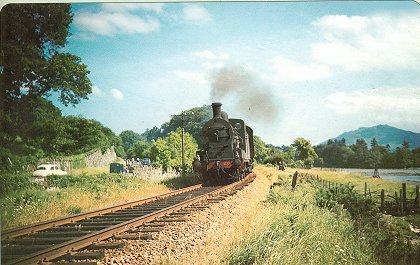I live within waving distance of a railway line; but, although I have kept a long and patient vigil, I have never once seen passengers fighting on the roof of a train – even a stationary one.
And yet if motion pictures are anything to go by, no sooner has the average train left the station than half the passengers scramble out of the windows and onto the roof, there to engage in every conceivable form of martial art – from Kung Fu to jujitsu, from kick-boxing to Sumo wrestling.
The archetypal motion-picture railway-traveller comes bounding into the station, vaults over the barrier, sprints along the platform, and hurls himself at the vanishing door-handle of the final carriage. With legs threshing wildly through the air and sparks flying from his steel-tipped shoes, he hauls himself upwards and clambers aboard, to the dismay of his fellow travellers. Pausing only to deftly adjust his slouch hat, he hefts his suitcase onto the rack, divests himself of his trench-coat and disappears out through the half-open window.
Even as our hero attempts to hoist himself onto the already populous roof of the train, a hobnailed oaf with
As the train rattles through each station, groups of demented passengers chase one another along the narrow corridors. Another gymnastic wretch clings precariously to the underside of a speeding carriage and, with his endangered skull dangling inches above the clattering rails, struggles to undo the couplings and disengage the final carriage.
In the course of each suicidal train journey, some rooftop swingers are hurled down embankments; some are swallowed up by tunnels; while others, having failed to duck in time, are decapitated by unexpected bridges.
Each evening as the railway barriers descend to interrupt our evening journey home and the long line of lighted windows pass in the darkness, we can only guess at what adventures are taking place on board the 17.25. All I ever see, however, are silhouetted figures reading evening newspapers or coyly eyeing one another’s reflections in the windows. As they hurtle through the countryside and thunder down tunnels, are they really unaware of the Olive Oyle look-alike tied to the line up ahead or the whooping band of Apache braves galloping menacingly alongside and discharging arrows tipped with flames?
All this frenetic cinematic activity is a far cry from the idyllic train journeys of the poetry books: from W.H. Auden’s, ‘This is the night mail crossing the border, bringing the cheque and the postal order’; and from Edward Thomas’s ‘Adlestrop’ where, ‘The steam hissed. Someone cleared his throat. No one left and no one came on the bare platform,’ – where the scene is one of, ‘willow-herb, and grass, and meadowsweet, and haycocks dry … blackbird song … and high cloudlets in the sky’.
It is far removed too from the musical train journeys of, ‘The Orange Blossom Special’ and the wailing harmonica blues trains of old. Yes, and even from the lonesome whistle of the late lamented Box Car Willie whose every song, be it ‘Waltzing Matilda’ or ‘Frankie and Johnny’, seemed to feature an incongruous locomotive whistling mournfully in the background.
The real romance of railways is all about pipe-smoking station masters tending colourful window-box displays in sleepy little country stations; it is about charismatic signalmen in dark uniforms and peak caps operating a thicket of levers in mysterious signal boxes; it is about eccentric train spotters crouched low in summer grasses entering names and numbers in well-thumbed pocket books; and it is about a scurry of schoolboy placing disposable coins on shimmering summer railway lines.
My own childhood memories are of the thud, clank and screech of wheels; the deafening hiss and blast of steam; the station guard’s ear-piercing whistle; and the chug and grunt of the iron monster as it commenced its six mile journey from Newry to Warrenpoint. I can almost see the eager faces at the windows … the Sunday suits … the open-necked shirts and the Tony Curtis hairstyles.
Minutes later, as the train approached its seaside destination, impatient travellers would lean out of the windows and inhale great gulps of thick smoke, unaware that the same locomotive smoke was blackening their well-scrubbed faces. Consequently, many an aspiring teenage Casanova wore an inadvertent grim-faced smile as he strutted around Warrenpoint in search of a jukebox jive and a fish and chip romance.
On one occasion back in the early sixties, we were travelling by train to support Down in the All-Ireland GAA Final at
Later, a pathetic looking figure shuffled into our carriage and observed the young card players for a few minutes. Clearing his throat apologetically, he asked if he could join in. Like all well-trained hustlers, he lost the first few games before depriving the poor red and black bedecked greenhorns of their collective savings.
‘All the best, lads,’ he grinned at the penniless poker players as he retreated like a bank robber with the takings.
Talk about ‘Gullibles’ Travels’!
A train passenger would be better off on the roof!
